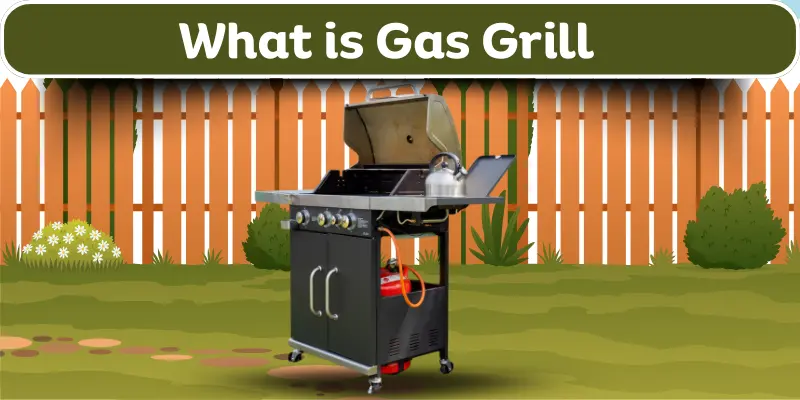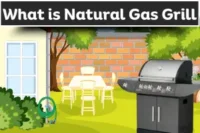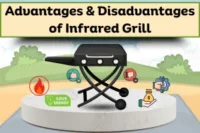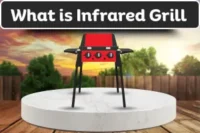What is Gas Grill – A Complete Beginner’s Guide to Easy Cooking
Published: 31 Aug 2025
Have you ever thought, what is gas grill and why do people love it? A gas grill is an outdoor cooking tool powered by propane or natural gas. It lights instantly and gets hot in minutes. You can cook burgers, steaks, or veggies with steady heat. No messy coals, no long wait times. It’s the easiest way to enjoy backyard grilling anytime.

What is Gas Grill?
A gas grill is a simple cooking appliance that uses propane or natural gas instead of charcoal. You turn a knob, press the ignition, and the burners start heating fast. People choose gas grills because they save time, give steady heat, and need little cleanup. For beginners, it’s the easiest type of grill to enjoy outdoor cooking without the hassle of charcoal.
How Does a Gas Grill Work?
A gas grill works by turning fuel into heat that cooks your food. It uses propane or natural gas to fire burners under the grates. The lid keeps the heat inside, so food cooks evenly. Let’s break down the process step by step.
Step 1 – Open the Gas Supply
Start by opening the propane tank or natural gas line. This lets gas flow into the grill. Always check for leaks before starting for safe cooking.
Step 2 – Light the Burners
Turn the control knobs on the front of the grill. Then press the ignition button to create a spark. The burners catch the gas and produce steady flames. These flames are the main heat source for your grill.
Step 3 – Heat Distribution
The burners heat the metal bars and grates above them. Some grills use flavorizer bars that catch drippings from food. These drippings turn into smoke, adding that smoky grilled flavor. With multiple burners, you can create different heat zones—high heat on one side for searing and low heat on the other for slow cooking.
Step 4 – Preheat the Grates
Let the grill run for a few minutes with the lid closed. This preheats the grates so they can sear food properly. Preheating also helps prevent sticking.
Step 5 – Start Cooking
Place your food on the hot grates. The flames below cook it quickly while the closed lid traps heat inside, working like an oven. The food gets those classic grill marks on the outside while staying juicy inside.
Step 6 – Control the Temperature
Use the knobs to adjust each burner. Want a quick sear? Turn one side to high. Want gentle cooking? Keep one side on low. This control is one of the biggest advantages of gas grills compared to charcoal.
Parts of a Gas Grill
A gas grill has several parts that work together to make outdoor cooking simple. Each part plays an important role in heating, cooking, and controlling your food. Let’s look at the main components one by one.
1. Burners
The burners are the heart of the grill. They release gas and create flames that heat the cooking area. Most grills have two to six burners, which helps spread heat evenly.
2. Ignition System
The ignition system lights the grill. With one press of a button or a quick turn of a knob, it creates a spark that sets the gas on fire. This makes starting the grill quick and safe.
3. Cooking Grates
Cooking grates sit above the burners. They hold your food and transfer heat directly. Strong grates also leave grill marks, which make food look and taste better.
4. Flavorizer Bars / Heat Tents
These metal bars cover the burners. They protect the burners from grease and drippings. At the same time, they turn the drippings into smoke, adding extra flavor to your food.
5. Gas Supply (Propane Tank or Gas Line)
A gas grill runs on propane or natural gas. A propane tank is portable and easy to replace, while a natural gas line gives a steady supply without refills. Both work well for grilling.
6. Lid & Thermometer
The lid traps heat inside the grill, just like an oven. Many lids come with a built-in thermometer. This helps you monitor the temperature without opening the grill.
7. Side Shelves and Storage (Optional)
Some grills have side shelves for holding plates, sauces, or tools. Many models also offer storage cabinets under the grill. These features make cooking easier and more organized.
Features of a Gas Grill
Gas grills are packed with features that make outdoor cooking simple and fun. These features help you start quickly, cook evenly, and clean with less effort.
- Push-Button Ignition – Start your grill with just one press. No matches needed.
- Adjustable Heat Control – Control the flame easily. High heat for steaks, low heat for veggies.
- Built-in Thermometer – The lid shows the cooking temperature. No need to keep opening it.
- Side Burners (Optional) – Cook sauces or side dishes while grilling.
- Rotisserie Setup (Premium Models) – Perfect for roasting chicken or meat evenly.
- Easy-to-Clean Drip Tray – A tray catches grease and makes cleaning simple.
- Portable vs. Freestanding Design – Take a portable grill for trips, or use a freestanding one at home.
Types of Gas Grills
Gas grills come in different types to fit different needs. Some are portable and easy to move, while others are built for permanent setups. A few even combine gas and charcoal for more flexibility. Let’s look at the main types of gas grills.
Propane Gas Grills
Propane gas grills are the most popular choice for many backyards. They run on propane tanks, which makes them portable and easy to set up anywhere. You can move them around or even take them for camping. They heat up fast and are simple to use, which is why beginners love them.
Natural Gas Grills
Natural gas grills connect directly to a natural gas line. They stay in one place because of the fixed connection, but they save money over time since natural gas is cheaper than propane. You never need to refill tanks, which makes them convenient for frequent grilling.
Hybrid Gas Grills
Hybrid gas grills give you the best of both worlds. You can cook quickly with gas when you want convenience. Or you can switch to charcoal when you crave smoky flavor. They are a bit more expensive but are perfect for grillers who want flexibility.
Uses of Gas Grills
Gas grills are not just for cooking burgers and hot dogs. You can use them in many ways to enjoy quick and tasty outdoor meals.
- Cook juicy steaks with perfect sear.
- Grill burgers and hot dogs for family cookouts.
- Roast vegetables with smoky flavor.
- Warm up bread or buns in minutes.
- Use indirect heat for slow cooking meat.
- Try rotisserie chicken with even cooking.
- Prepare quick weeknight dinners outdoors.
Pros and Cons of Gas Grills
Gas grills are loved for their speed and ease of use. But like any grill, they have both good and bad sides. Knowing the pros and cons of gas grill will help you decide if a gas grill is the right choice for you.
| Benefits of Gas Grills |
|---|
Gas grills are simple to use and save you time while cooking outdoors. They offer comfort, speed, and less mess.
|
| Drawbacks of Gas Grills |
|---|
Gas grills are convenient, but they do come with a few downsides. Here are some common ones to know:
|
Conclusion
So, guys, now let’s conclude this topic. We have explored in detail what is gas grill, how it works, and why it is useful. A gas grill makes cooking faster, cleaner, and easier compared to charcoal. If you’re still wondering what is a gas grill best used for, the answer is simple — quick meals, family cookouts, and hassle-free grilling. Get one today and enjoy outdoor cooking without stress!
Frequently Asked Questions About Gas Grills
If you are new to grilling, you might have many questions in mind. Don’t worry, here are some beginner-friendly FAQs about what is gas grill and how it works.
A gas grill is a cooking device that runs on propane or natural gas. It heats burners that cook your food quickly. You just push a button to start and adjust the heat with knobs. It’s simple, clean, and perfect for outdoor cooking.
A gas grill works by sending gas from a propane tank or gas line to burners. The burners create flames that heat the cooking grates. You place food on the grates, close the lid, and control the temperature with knobs. It’s fast and easy to use.
A gas grill uses propane or natural gas for fuel, while a charcoal grill uses charcoal briquettes. Gas grills heat up faster and are easier to clean. Charcoal grills give a smoky flavor but take more time to start and clean.
Yes, gas grills are safe when used correctly. Always keep the grill outdoors and at least 10 feet from your house. Check connections before use and never leave it unattended. With basic care, beginners can use it without worry.
You can cook almost anything on a gas grill. Popular options include burgers, hot dogs, steaks, chicken, and veggies. Some grills even come with side burners or rotisserie setups. You can easily cook quick meals for family and friends.
Gas grills give a clean taste but a less smoky flavor compared to charcoal. However, you can use smoker boxes or wood chips to add that smoky touch. This way, you get both convenience and flavor in one grill.
If you cook for a small family, a 2-3 burner grill is enough. For bigger gatherings, go for 4-6 burners. Always check your backyard space before buying. Pick the size that matches your cooking style and family needs.
A standard 20-pound propane tank usually lasts 18–20 hours on a medium grill. Cooking time depends on heat settings and how often you grill. Always keep an extra tank handy to avoid running out during a cookout.
No, gas grills are cost-effective. Propane tanks are affordable, and natural gas is even cheaper if you have a fixed line. They cost less to run than buying bags of charcoal often. Long-term, gas grills save both time and money.
No, never use a gas grill indoors. It produces carbon monoxide, which is dangerous in closed spaces. Always use it outside in the open air. Keep it in a safe spot away from walls, trees, or anything flammable.

- Be Respectful
- Stay Relevant
- Stay Positive
- True Feedback
- Encourage Discussion
- Avoid Spamming
- No Fake News
- Don't Copy-Paste
- No Personal Attacks



- Be Respectful
- Stay Relevant
- Stay Positive
- True Feedback
- Encourage Discussion
- Avoid Spamming
- No Fake News
- Don't Copy-Paste
- No Personal Attacks



